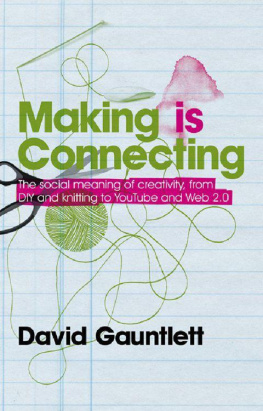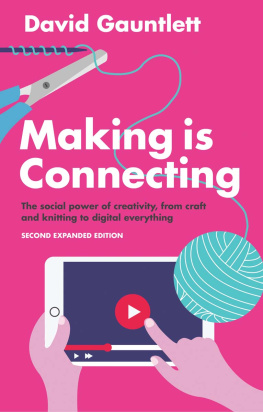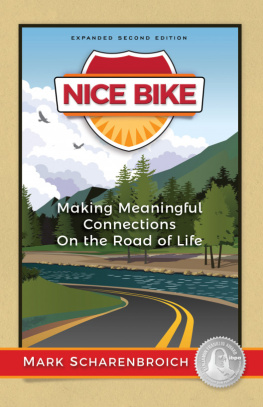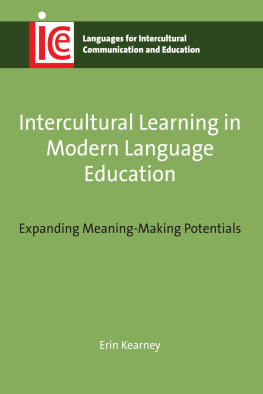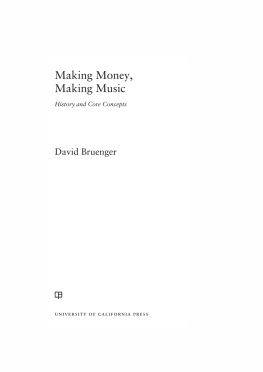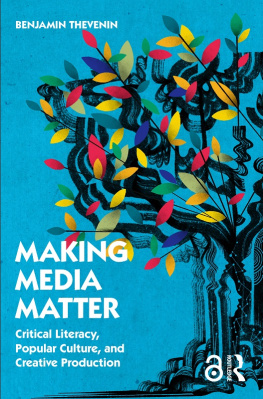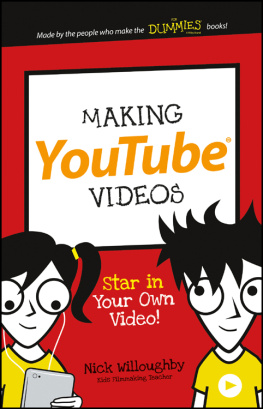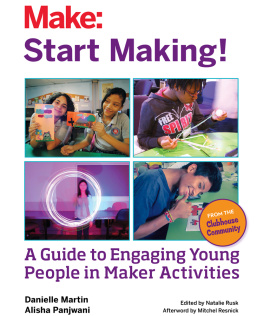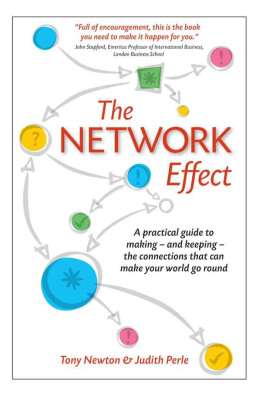MAKING IS CONNECTING
MAKING IS CONNECTING
The social meaning of creativity, from DIY and knitting to YouTube and Web 2.0
DAVID GAUNTLETT
polity
Copyright David Gauntlett 2011
The right of David Gauntlett to be identified as Author of this Work has been asserted in accordance with the UK Copyright, Designs and Patents Act 1988.
First published in 2011 by Polity Press
Polity Press
65 Bridge Street
Cambridge CB2 1UR, UK
Polity Press
350 Main Street
Malden, MA 02148, USA
All rights reserved. Except for the quotation of short passages for the purpose of criticism and review, no part of this publication may be reproduced, stored in a retrieval system, or transmitted, in any form or by any means, electronic, mechanical, photocopying, recording or otherwise, without the prior permission of the publisher.
ISBN-13: 978-0-7456-3776-1
A catalogue record for this book is available from the British Library.
Typeset in 10.75 on 14 pt Adobe Janson
by Servis Filmsetting Ltd, Stockport, Cheshire
Printed and bound in Great Britain by MPG Books Group Limited, Bodmin, Cornwall
The publisher has used its best endeavours to ensure that the URLs for external websites referred to in this book are correct and active at the time of going to press. However, the publisher has no responsibility for the websites and can make no guarantee that a site will remain live or that the content is or will remain appropriate.
Every effort has been made to trace all copyright holders, but if any have been inadvertently overlooked the publisher will be pleased to include any necessary credits in any subsequent reprint or edition.
For further information on Polity, visit our website: www.politybooks.com
For Finn
CONTENTS
ACKNOWLEDGEMENTS
I am very grateful to my colleagues in the Communication and Media Research Institute (CAMRI), University of Westminster, for useful conversations and support, especially Pete Goodwin, Colin Sparks, Sally Feldman, Geoffrey Davies, Fatimah Awan, Jeanette Steemers, Anastasia Kavada, Tim Riley, Caroline Dover, Charles Brown, Anthony McNicholas, and David Hendy.
I am glad to acknowledge the UKs Arts and Humanities Research Council (AHRC), and the Research Councils UK Digital Economy programme, for research awards which, although not specifically supporting this project, did fund related work and gave me time to think about these things. These include four projects which commenced between 2007 and 2010, with the reference numbers AH/H038736/1, AH/F009682/1, AH/F006756/1, and EP/H032568/1. And I am grateful to Fatimah Awan and Anna Piela, for working hard on these projects when I wasnt.
Many thanks to Jenny Gauntlett, Pete Goodwin, and Andrea Drugan, who took the trouble to read the whole manuscript, and made invaluable suggestions. Politys anonymous reviewer, who later revealed himself to be Andrew Dubber, also provided excellent comments. Nick Couldry and Dougald Hine helped to spark ideas in general, and provided useful suggestions on the conclusion in particular.
Thank you to Andrea Drugan at Polity for being such a supportive editor. Lauren Mulholland, Clare Ansell, and the copy-editor, Jane Fricker, have also been very helpful.
Tessy Britton, always full of examples of exciting community projects and other creative things, deserves special mention, and Cecilia Weckstrm at Lego was another inspiring source of things to think about. For general encouragement and support, and/or useful discussions, I am also grateful to Annette Hill, Knut Lundby, Paul Sweetman, Sonia Livingstone, Peter Lunt, Amanda Blake Soule, Jesper Just Jensen, Anna-Sophie Trolle Terkelsen, David Brake, Lizzie Jackson, Edith Ackermann, Thomas Wolbers, David Whitebread, and the super people at the School of Everything Unplugged meetups, including David Jennings, Tony Hall, and Alison Powell.
Thanks also to the students who took my new and untested Creativity module at the University of Westminster in spring 2010.
As ever, love and thanks to Jenny and Finn for supporting and inspiring me every day. And as always, the responsibility for any errors, weird arguments, sentimentality, and unreasonable optimism that you may find here remains my own.
INTRODUCTION
This is a book about what happens when people make things. I hope it will add to the conversation about the power of the internet and the World Wide Web a place where we have seen everyday creativity flourish in recent years. But people have been making things and thinking about the meaning of making things for a very long time. And the power of making, and connecting through creating, extends well beyond the online world to all kinds of activities in everyday life.
I hope to pull some of these things together, in ways which are hopefully not too obvious as we start. You may reasonably wonder, for instance, how a commentary by Victorian art critic John Ruskin on medieval cathedrals can have affected my understanding of YouTube videos. And you may be surprised when the nineteenth-century socialist and tapestry-weaver William Morris dispenses a blueprint for the making and sharing ethos of Web 2.0 in general, and Wikipedia in particular, 120 years early. We will note how the former Catholic priest and radical philosopher Ivan Illich outlined the necessary terms of human happiness, 40 years ago, see how it lines up with the latest studies by economists and social scientists today, and then connect it with knitting, guerrilla gardening, and creative social networks. But not necessarily in that order. We will encounter the 1970s feminist Rozsika Parker, explaining embroidery as a weapon of resistance, and several knitters, badge-makers, and bloggers, and they will help us to think about how making things for ourselves gives us a sense of wonder, agency, and possibilities in the world.
MAKING IS CONNECTING
This brings us to the title of the book: Making is connecting. Its a perfectly simple phrase, of course. But having spent some time thinking about people making things, and people connecting with others making and connecting I realized that it was meaningful, and more pleasing, to note that these are one and the same process: making is connecting.
I mean this in three principal ways:
Making is connecting because you have to connect things together (materials, ideas, or both) to make something new; |
Making is connecting because acts of creativity usually involve, at some point, a social dimension and connect us with other people; |
And making is connecting because through making things and sharing them in the world, we increase our engagement and connection with our social and physical environments. |
Of course, there will be objections and exceptions to each of these, which we may consider along the way. But thats my basic set of propositions.
THREE REASONS WHY I WANTED TO WRITE THIS BOOK
This book came about because of a number of things I had been thinking about, which I hope are worth listing briefly here.
First, I started out as a sociologist interested in the place of media in peoples lives. That was OK for a while, but 15 and even 10 years ago, the main media that people were usually dealing with was produced by big professional organizations, and it seemed somewhat subservient to be exploring what people were doing with their products. Some of the activity was quite active, thoughtful, and imaginative, some of it was mundane, and none of it could score very highly on a scale of creativity because it was all about creative works made by other people. Thankfully, the World Wide Web soared in popularity, becoming mainstream in itself, and opened up a world of diversity and imagination where the content itself is created by everyday users (as well as a growing number of professionals). This opportunity to make media and, in particular, share it easily, making connections with others, was unprecedented in both character and scale, and therefore a much more exciting thing to study.
Next page
